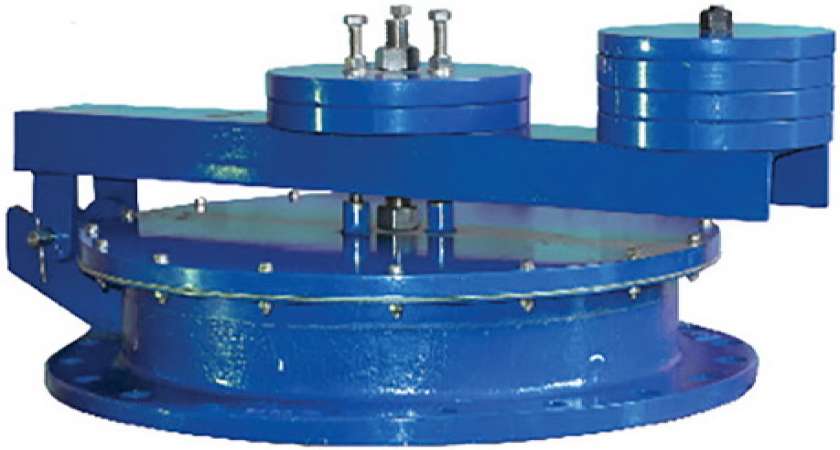
EMERGENCY PRESSURE-VACUUM RELIEF VENTS

Description
Emergency Vent Covers are designed to provide emergency relief capacity beyond that furnished by the operating vent on tanks.
Under normal operating conditions, the vent pallet assembly is closed providing an effective vapor seal. In the event of an emergency (fire involvement of the tank), the pallet lifts in response to the increased pressure in the tank’s vapor space. Vapor is expelled, thereby protecting the tank from dangerous over-pressurization. Pallet assembly automatically closes and reseals when the pressure is reduced.
The units provide emergency venting capacity in the event of fire.
These vents are designed to provide an emergency pressure relief opening for storage tanks when exposed to over pressures that are not handled by standard tank vents. Properly sized, these vents provide the capacity to meet API Standard 2000 for emergency venting due to fire exposure.
These covers can be also quick and easy access to storage tanks for inspection and maintenance.
The venting can be only pressure or pressure and vacuum.
The emergency pressure relief vents provide pressure relief only, and the emergency pressure-vacuum relief vents provide both pressure and vacuum relief.
Principle of Operation
Emergency Vents are fitted to storage tanks to allow emergency flow due to the excessive venting requirement from a fire burning around a storage tank. This eliminates a costly tank rupture, providing emergency venting from abnormal internal pressure beyond the capability of the pressure relief vent. In the event of a fire, the vent will open at a pre-determined pressure, thus creating a large venting area.
A PTFE insert is provided to achieve leak tight sealing between the vent and seat under normal operating conditions. The Operational Tank Venting System or Pressure/Vacuum Relief Valves handle normal tank venting due to product import/export and ambient temperature variations. In the event of fire engulfment, as the vapor pressure in the tank increases to a point where normal venting equipment capacity is exceeded, the hinged cover will lift, relieving the pressure and protecting the tank from rupture.
The pressure build-up will be quite slow, therefore the cover should not open violently and cause any damage to the tank. Emitted vapors may well be ignited by the fire, but should ‘flame-off’ externally until brought under control by fire fighting operations. Emergency Vents will not normally afford protection against internal tank vapor explosions from static discharges etc, due to the fact that the pressure build-up will be very rapid and exceed the capacity of the device. In this instance, the cover will snap open violently and may well cause damage to the tank, it is however likely that there will be more significant damage elsewhere on the fabric of the tank from the internal explosion.
Pressure Relief
As the pressure in the storage tank increases, when the set pressure is reached, the pressure pallet lifts and relieves to atmosphere.
Vacuum Relief
An alternative model is available, fitted with an additional spring-loaded vacuum valve that will open under negative pressure to protect the tank from any damage that may occur under vacuum conditions.
The Different Types of Emergency Vents
Basically in function and performance, End of Line Emergency Vents are available in two different types, they are Emergency Pressure and Emergency Pressure-Vacuum types.
Depend on the values of set pressure and set vacuum, End of Line Emergency Vents are produced in two different major types/categories. They are weight loaded and spring loaded types, where both they are advanced designed for vent to atmosphere applications.
And in production, they are available in various designs/models, as follows:
1. PLAIN COVER WEIGHT LOADED EMERGENCY PRESSURE VENTS
2. HINGED COVER WEIGHT LOADED EMERGENCY PRESSURE VENTS
3. WEIGHT LOADED EMERGENCY PRESSURE-VACUUM RELIEF VENTS
4. SPRING LOADED EMERGENCY PRESSURE VENTS
5. SPRING LOADED EMERGENCY PRESSURE-VACUUM VENTS
Application
The application can be for all working mediums such as gasoline, kerosene, diesel oil, aromatic naphtha, air, etc. or other petrochemical materials.
Standard of Manufacture and Inspection
Manufacture and inspection refer to the standard “SY/T0511.1-2010”.
Remark: Flange connection adopt HG/T20592-2010, PN1.0 MPa, and also available on request according to HG, JB, ANSI-B16.5, JIS.
Construction
The item’s body materials are available in Aluminum, Cast Iron, Carbon Steel, Cast-Carbon Steel, 304 Stainless Steel, 316 Stainless Steel, and other metals on request.
As our standard, Iron and carbon steel materials are supplied in Epoxy finish coated.
Standard sizes range from 2" (DN50) to 12" (DN300) with flange drilling according to ANSI #150 or API 650, FF flanges as standard, but different connections such as DIN, JIS standard, and other designs are available on request.
Explosion level: IIA, IIB, IIC
Setting Pressure
Set pressure range for weight loaded type : 1.5kPa (153mmH2O / 15mbar) ~ 5kPa (510mmH2O / 50mbar)
Set pressure range for spring loaded type : 5kPa (510mmH2O / 50mbar) ~ 100kPa (10197mmH2O / 1bar)
Temperature
Ambient temperature : -20 ºC to +60 ºC
Body and seal are designed for process temperature ranges : -70 ºF (-21 ºC) to 400 ºF (+204 ºC)
Sizes
Sizes range : 8" (ND200) ~ 24” (ND600)
Features and Benefits
• Wide range of sizes and materials to suit diverse applications.
• Wide range of pressure settings to provide maximum tank protection whilst ensuring minimum product vapor.
• Low cost maintenance.
• Simple and low cost maintenance and cleaning
• Superior quality
Ordering Information
Specify:
1. Pressure only or pressure and vacuum
2. Value of set pressure and set vacuum (if required)
3. Model (depend on the function of operation and required value of set pressure and set vacuum)
4. Body material
5. Size
6. Type of connection flange
7. Flange standard based on ANSI, JIS, DIN, or API
8. Rating class of flange